
Scrooby is a small village on the River Ryton in north Nottinghamshire, England, near Bawtry in South Yorkshire. At the time of the 2001 census it had a population of 329, in 2011 the count was 315 and by the 2021 census this had fallen further to 307 residents. Until 1766, it was on the Great North Road so became a stopping-off point for numerous important figures including Queen Elizabeth I and Cardinal Wolsey on their journeys. The latter stayed at the Manor House briefly, after his fall from favour.
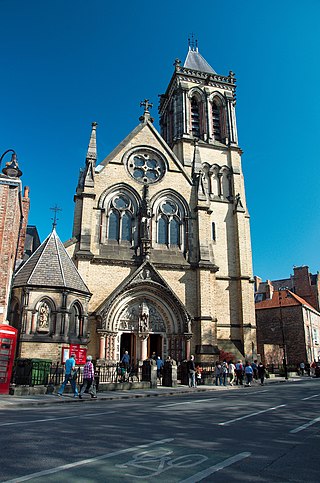
The Oratory Church of Saint Wilfrid, York is a Catholic church in York, England.

St Mary's Church, Fetcham, Surrey, England is a Church of England parish church (community) but also refers to its building which dates to the 11th century, that of the Norman Conquest and as such is the settlement's oldest building. It is set off the residential road of its address, The Ridgeway, behind a small park, in the suburban part of the largely 20th century railway settlement adjoining the M25 London Orbital Motorway which has retained farmed rural outskirts. The closest secular building is Grade II* listed Fetcham Park House, which is in the same architectural category and the church has an adjoining church hall.

Carlton in Lindrick is a village and civil parish about 3 miles (5 km) north of Worksop in Nottinghamshire, England. The 2011 Census recorded a parish population of 5,623, including nearby Wallingwells. The 2021 Census reported alone on Carlton in Lindrick, with 5,635 residents.
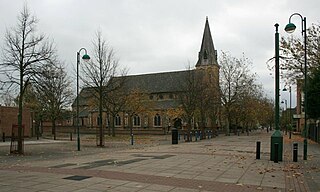
Saint Saviour's Church is a parish church in the Church of England in The Meadows, Nottingham.
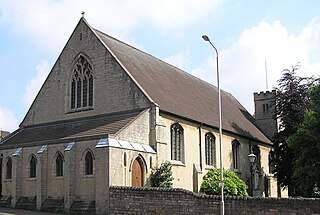
St. Mark's Church is on Nottingham Road, Mansfield, Nottinghamshire, England. It is an active Church of England parish church in the deanery of Mansfield, the archdeaconry of Newark, and the Southwell and Nottingham diocese. The church is recorded in the National Heritage List for England as a designated Grade II* listed building. Behind the church, the church hall is a Grade II listed building.
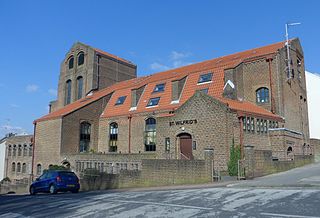
St Wilfrid's Church is a former Anglican church in the Elm Grove area of Brighton, part of the English city of Brighton and Hove. Designed and built in the 1930s to replace a temporary building in the densely populated Elm Grove area, its unusual design—not conforming with architectural norms of the era—was widely praised. It was declared redundant after less than 50 years as a place of worship, and was converted into sheltered housing with minimal alteration to the exterior. Shortly after its closure, it was granted Grade II listed status.

St Wilfrid's Church is an Anglican church in the town of Haywards Heath in the district of Mid Sussex, one of seven local government districts in the English county of West Sussex. It is Haywards Heath's parish church, and is the mother church to two of the town's four other Anglican churches. Designed in the Decorated Gothic style by George Frederick Bodley, it was built between 1863 and 1865 as the town began to grow rapidly, and stands in a prominent position on the highest ground in the area. English Heritage has listed it at Grade II* for its architectural and historical importance.

St Leonard's Baptist Church is the Baptist place of worship serving St Leonards-on-Sea, a town and seaside resort which is part of the Borough of Hastings in East Sussex, England. The elaborate building was designed by the architectural firm of Thomas Elworthy, responsible for many churches in late-Victorian era Sussex, and serves the residential hinterland of St Leonards-on-Sea—an area which grew rapidly after its early 19th-century founding by James Burton. English Heritage has listed the church at Grade II for its architectural and historical importance.

Busbridge Church or St John the Baptist Church, is an evangelical Anglican Church in Busbridge, Godalming, England. Busbridge Church is part of a joint benefice with Hambledon Church in the village of Hambledon, Surrey. Together Busbridge and Hambledon Church have six Sunday congregations ranging from traditional to modern and contemporary services. On a Sunday Busbridge Church and Hambledon Church put on youth and children's groups for over 200 young people.
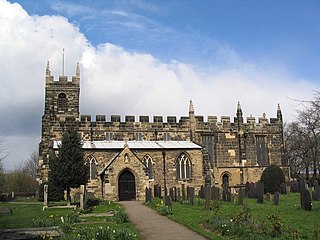
St Wilfrid's Church, Wilford is a Grade II* listed parish church in the Church of England in Wilford, Nottinghamshire, England.

St Richard of Chichester Church is a Roman Catholic parish church in Chichester, West Sussex, England. The church was built in 1958 and contains the largest scheme of stained glass by Gabriel Loire in the United Kingdom. The church is situated on Market Avenue on the corner of Cawley Road, next to St Richard's Catholic Primary School. It is a Grade II listed building.

Our Lady of Sorrows Church is a Roman Catholic Parish church in Bognor Regis, West Sussex, England. It was built from 1881 to 1882 and designed by Joseph Stanislaus Hansom. It is situated on the corner of the High Street and Clarence Road, backing on to Albert Road, in the centre of the town. It was founded by the Servite Order and is a Grade II listed building.

St Anthony of Padua Church is a Roman Catholic Parish church in Rye, East Sussex, England. It was constructed from 1927 to 1929 and replaced a church built in 1900. It is situated on Watchbell Street to the south of Lamb House. It is served by the Conventual Franciscans and is a Grade II listed building.

St Wilfrid's Church in George Street, Hulme, Manchester, England, was a Roman Catholic place of worship. Designed by Augustus Pugin, it was his only known church building in that city.

Marnham is a civil parish in the Bassetlaw district, in the county of Nottinghamshire, England. The parish includes the village of Low Marnham and the hamlets of High Marnham and Skegby. In the census of 2021 the parish had a population of 136. The parish lies in the north east of the county, and south east within the district. It is 122 miles north of London, 23 miles north east of the city of Nottingham, and 17 miles north east of the market town of Mansfield. The parish touches Fledborough, Normanton on Trent, South Clifton, Tuxford and Weston. Marnham shares a parish council with Normanton on Trent. There are 7 listed buildings in Marnham.
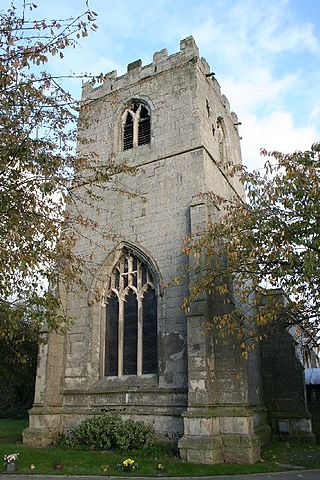
North and South Wheatley is a civil parish in the Bassetlaw district, in the county of Nottinghamshire, England. The parish includes the villages of North Wheatley and South Wheatley. In 2021 the parish had a population of 610 residents. It is 130 miles north of London, 30 miles north east of the county town of Nottingham, and 5 miles north east of the Nottinghamshire town of Retford. The parish touches Bole, Clarborough and Welham, Clayworth, Hayton, Saundby, Sturton Le Steeple and West Burton. There are 18 listed buildings in North and South Wheatley.

The Weybridge United Reformed Church situated at Queen's Road, Weybridge, near to its junction with York Road, is a Victorian Grade II Listed church building that is now no longer used as a place of worship.
Scrooby is a civil parish in the Bassetlaw District of Nottinghamshire, England. The parish contains 17 listed buildings that are recorded in the National Heritage List for England. Of these, one is listed at Grade II*, the middle of the three grades, and the others are at Grade II, the lowest grade. The parish contains the village of Scooby and the surrounding countryside, and the listed buildings include houses, cottages and associated structures, churches, farmhouses and farm buildings, a former watermill, a pinfold, a war memorial, and a telephone kiosk.



















